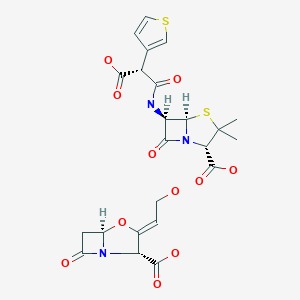Attribution Statement: LactMed is a registered trademark of the U.S. Department of Health and Human Services.
NCBI Bookshelf. A service of the National Library of Medicine, National Institutes of Health.
Drugs and Lactation Database (LactMed®) [Internet]. Bethesda (MD): National Institute of Child Health and Human Development; 2006-.
CASRN: 86482-18-0

Drug Levels and Effects
Summary of Use during Lactation
Limited information indicates that ticarcillin produces low levels in milk that are not expected to cause adverse effects in breastfed infants. Clavulanic acid has not been studied in nursing mothers. Occasionally disruption of the infant's gastrointestinal flora, resulting in diarrhea or thrush have been reported with penicillins, but these effects have not been adequately evaluated. Ticarcillin and clavulanic acid is acceptable is acceptable in nursing mothers.
Drug Levels
Maternal Levels. No studies on the combination of ticarcillin and clavulanic acid during breastfeeding have been reported. Only trace levels of ticarcillin were detected for 6 hours after single 1 gram intramuscular doses in 3 women in one study[1][2] and 5 women in another early study.[3]
After ticarcillin doses of 5 grams intravenously three times a day in 10 women, milk levels averaged 2 to 2.5 mg/L. By 12 hours after the last dose, ticarcillin was undetectable in the milk. The total daily intake of a breastfed infant would be negligible.[4]
Infant Levels. Relevant published information was not found as of the revision date.
Effects in Breastfed Infants
Relevant published information was not found as of the revision date.
Effects on Lactation and Breastmilk
Relevant published information was not found as of the revision date.
References
- 1.
- Matsuda S, Tanno M, Kashiwakura T et al. Laboratory and clinical use of ticarcillin. Chemotherapy (Tokyo). 1977;25:2924-31.
- 2.
- Matsuda S. Transfer of antibiotics into maternal milk. Biol Res Pregnancy. 1984;5:57-60. [PubMed: 6743732]
- 3.
- Cho N, Nakayama T, Uehara K et al. Laboratory and clinical evaluation of ticarcillin in the field of obstetrics and gynecology. Chemotherapy (Tokyo). 1977;25:2911-23.
- 4.
- von Kobyletzki D, Dalhoff A, Lindemeyer H et al. Ticarcillin serum and tissue concentrations in gynecology and obstetrics. Infection. 1983;11:144-9. [PubMed: 6885173]
Substance Identification
Substance Name
Ticarcillin and Clavulanic Acid
CAS Registry Number
86482-18-0
Drug Class
- Breast Feeding
- Anti-Infective Agents
- Antibacterial Agents
- Penicillins
Disclaimer: Information presented in this database is not meant as a substitute for professional judgment. You should consult your healthcare provider for breastfeeding advice related to your particular situation. The U.S. government does not warrant or assume any liability or responsibility for the accuracy or completeness of the information on this Site.
- User and Medical Advice Disclaimer
- Drugs and Lactation Database (LactMed) - Record Format
- LactMed - Database Creation and Peer Review Process
- Fact Sheet. Drugs and Lactation Database (LactMed)
- Drugs and Lactation Database (LactMed) - Glossary
- LactMed Selected References
- Drugs and Lactation Database (LactMed) - About Dietary Supplements
- Breastfeeding Links
- PubChem SubstanceRelated PubChem Substances
- PubMedLinks to PubMed
- Review Amoxicillin and Clavulanic Acid.[Drugs and Lactation Database (...]Review Amoxicillin and Clavulanic Acid.. Drugs and Lactation Database (LactMed®). 2006
- Review Ampicillin and Sulbactam.[Drugs and Lactation Database (...]Review Ampicillin and Sulbactam.. Drugs and Lactation Database (LactMed®). 2006
- Review Ticarcillin.[Drugs and Lactation Database (...]Review Ticarcillin.. Drugs and Lactation Database (LactMed®). 2006
- Review Piperacillin and Tazobactam.[Drugs and Lactation Database (...]Review Piperacillin and Tazobactam.. Drugs and Lactation Database (LactMed®). 2006
- Review Penicillin G.[Drugs and Lactation Database (...]Review Penicillin G.. Drugs and Lactation Database (LactMed®). 2006
- Ticarcillin and Clavulanic Acid - Drugs and Lactation Database (LactMed®)Ticarcillin and Clavulanic Acid - Drugs and Lactation Database (LactMed®)
Your browsing activity is empty.
Activity recording is turned off.
See more...
